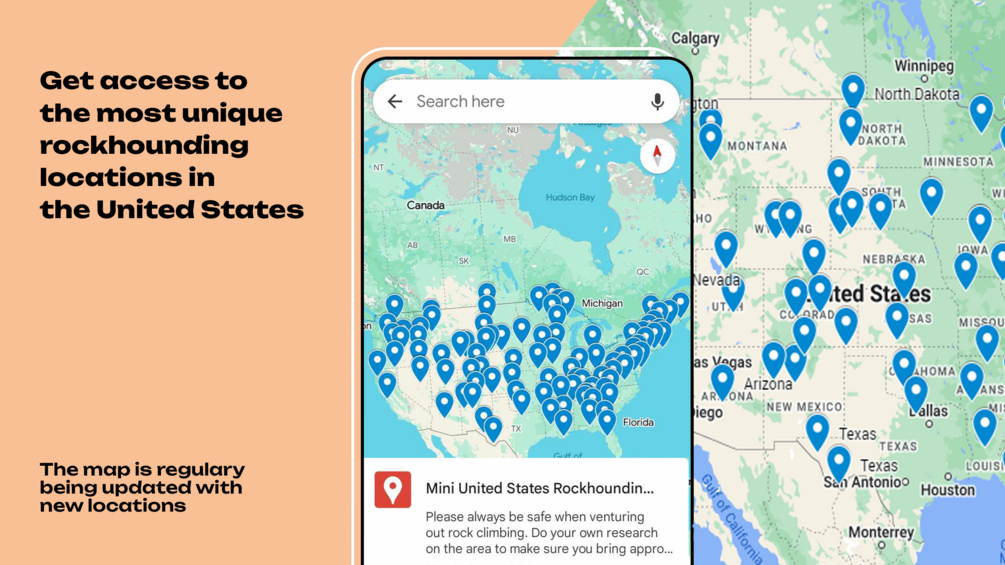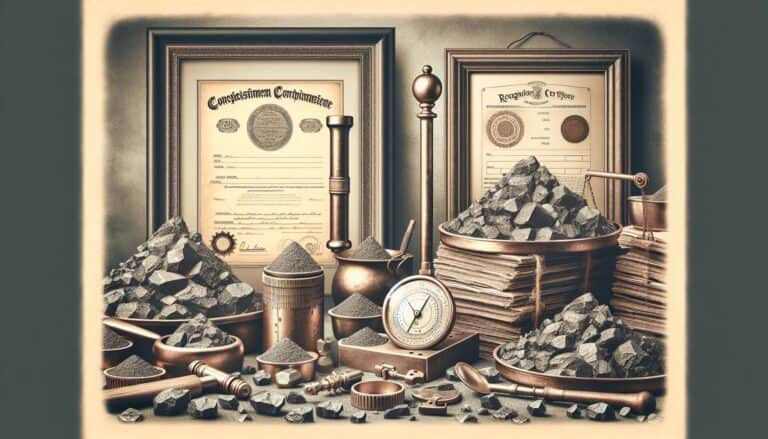Ready to uncover California’s geological treasures?
Rockhounding in the Golden State is an adventurer’s delight, offering a plethora of stunning gems and minerals. From the sun-soaked deserts to the rugged coastlines, you’ll find spots teeming with hidden wonders.
Whether you’re a seasoned rockhound or just starting, California’s diverse terrain is your playground. You’re about to discover prime locations that promise an exciting quest for quartz, tourmaline, gold, and more.
Strap on your boots, grab your gear, and let’s dig into the hotspots where Mother Nature’s bounty awaits.
California, a rockhound’s paradise, offers diverse locations for unearthing geological treasures. Explore the Mojave Desert for geodes and gold, Northern California’s Coast for jade and agates, the Sierra Nevada for gold and quartz, and Inyo County for obsidian. Each location promises unique finds, showcasing California’s rich geological diversity.
Get our FREE United States Rockhounding Map HERE

California Rockhounding Locations
Embarking on rockhounding in California, you’re spoilt for choice with a wealth of locations at your fingertips. Here’s a look at some prime spots where treasures beneath the earth reveal themselves to those who seek.
The Mojave Desert
Gems and minerals abound in this vast expanse. You might stumble upon geodes brimming with crystal formations or trinkets of gold if you’re particularly lucky. The desert’s Klinker Opal Mine is well-known for harboring opalised volcanic ash layers.
Northern California’s Coast
Rockseekers often head to the coast for jade and agates. The beaches are renowned for their smooth, sea-polished gems. Mendocino County’s Big Sur offers prime rockhounding spots, with jade being especially abundant after winter storms.
The Sierra Nevada
This mountain range is a favorite among prospectors. You could strike it rich with finds such as gold and quartz. The historic Gold Country, east of Sacramento, offers not only beautiful scenery but also a chance to pan for real gold in the American River.
Inyo County
Home to ancient volcanic craters and extensive lava flows, Inyo County is rich with obsidian. The Glass Butte field is particularly popular for collecting this naturally occurring volcanic glass, prized for its sharpness and luster.
Safety First: Always come prepared. The terrain can be rugged and weather unpredictable. Ensure you’ve got adequate water, sun protection, and proper tools for digging and carrying your finds.
What Gemstones are Found in California?

California is not only a hub for spectacular sights and entertainment; it’s also a treasure trove for gemstone enthusiasts. Home to over 100 types of gems and minerals, the state offers a colorful spectrum of sparkling stones waiting to be discovered.
Amongst the most sought-after are tourmaline, jade, and benitoite—the latter being the state gemstone unique to the area. Tourmaline comes in a variety of colors, and some of the finest specimens in the world have been mined in Southern California’s San Diego County. Green and blue varieties, especially, can be discovered at the famous Himalaya Mine and Stewart Mine.
Jade, another precious find, is typically found along the beaches of Big Sur. Here, you’re likely to stumble upon nephrite jade, particularly after storms when the waves have churned up the ocean floor and deposited treasures onto the shore.
Benitoite, a captivating blue gemstone, is most commonly found at the Benitoite Gem Mine in San Benito County. This rare and beautiful crystal can fetch high prices and is a must-find for serious rockhounds.
Garnets, loved for their deep red hue, can also be found in California. They are primarily located in the Sierra Nevada range, adding to your potential haul of glistening finds.
For those fascinated by the glimmer of gold, the state’s rich history during the Gold Rush in the mid-1800s is not something you’ll want to overlook. Pan for gold flakes and nuggets in rivers such as the American River and the Yuba River, where prospectors once sought their fortunes.
Here’s a quick glance at some of the gemstones you might come across:
- Tourmaline: Especially in San Diego County
- Jade: Commonly on the beaches of Big Sur
- Benitoite: In San Benito County
- Garnets: Throughout the Sierra Nevada range
- Gold: Along the American and Yuba Rivers
Remember, identifying gemstones in their natural state requires a keen eye and often, the right tools. So pack your geological hammer, chisels, and safety goggles, and be ready for a hands-on adventure that could lead to sparkling souvenirs.
What Sedimentary Rocks You Can Find in California?

California’s geology is as diverse as its landscape, offering an abundance of sedimentary rocks to the keen rockhound. When you’re scouring the state’s vast terrains, you’re likely to come across a variety of sedimentary treasures.
One of the most sought-after sedimentary rocks in California is limestone. Known for containing fossilized remains, limestone is particularly abundant in the state’s mountain ranges. Shasta County, for instance, is a hotspot where limestone can often be found with traces of ancient marine life.
Sandstone, another prevalent sedimentary rock, is widely distributed across the state. Notably, the cliffs of Santa Barbara and the iconic rock formations of Zion National Park are magnificent examples of what sandstone erosion can create over time. As a rockhound, you’ll find that many areas, especially coastal zones and desert basins, present abundant opportunities to find unique sandstone specimens.
Additionally, the state is home to shale formations, which can be rich in organic material and sometimes bear oil. Regions like the Monterey Formation have layers of shale that showcase California’s ancient aquatic past. For those interested in rock layers and the stories they tell, shale offers a window into historical geological events.
In your search for sedimentary rocks, you might also discover chert, particularly in areas that have been influenced by volcanic activity. Chert, often found in shades of red or green, is typically associated with areas where siliceous ooze had accumulated on the ocean floor before being uplifted by tectonic activity.
As you explore these sedimentary finds, remember that each rock can provide insight into the environmental conditions that existed when it was formed. In California, the abundance of sedimentary rock varieties is a testament to the state’s rich geological history. Be sure to equip yourself with a geological map and a sturdy hammer as you delve into the sedimentary layers that California has to offer.
What Metamorphic Rocks are found in California?
As you venture out on your California rockhounding trip, you’ll discover that the Golden State is not just rich in sedimentary rocks but also boasts an array of stunning metamorphic rocks. These rocks are known for their mesmerizing swirls and patterns—a true geologist’s treasure.
Marble, schist, and quartzite are among the most sought-after metamorphic rocks in California. Each one tells a unique story of transformation—of minerals once buried deep within the Earth, altered by intense heat and pressure over millennia.
Marble, with its classic elegance, can be found in Inyo County, renowned for deposits that have an almost luminescent quality. This area is famous among rockhounds for its accessibility and the quality of specimens available.
Turning your attention to schist, you’ll discover that the Angeles National Forest is a prime area for finding this rock. Schist is noticeable for its shiny appearance and layered structure, traits that result from its formation process involving large directional pressures that realign mineral grains.
If you’re on the hunt for quartzite, then the San Bernardino Mountains are your go-to destination. This rock is incredibly durable and known for its glassy luster. It forms from sandstones that have undergone extreme compression and heating, altering their original structure to create the hard quartzite you find today.
Be sure to bring along a sturdy hammer and chisels as you’ll need them to carefully extract samples without damaging their integrity. Additionally, always remember to respect the land and local regulations; some areas may prohibit collection, so it’s vital to check for permissions beforehand.
As you explore these locales and uncover their hidden geological gems, keep in mind that the state’s rich tapestry of rocks is a window into its deep geological past and the colossal forces that shaped the landscape.
What Igneous Rocks can You Find in California?
When you’re on the hunt for igneous rocks, California’s geology won’t disappoint. The state’s rich volcanic history has left behind an impressive array of these once-molten treasures. Granite, basalt, and obsidian are three of the primary igneous rocks you’ll encounter.
Granite, with its coarse-grained texture and varied colors, is the backbone of the Sierra Nevada range. Whether you’re in Yosemite National Park or the desolate beauty of Joshua Tree National Park, you’ll marvel at the vast granite formations. In particular, the famed Half Dome in Yosemite is not only a breathtaking sight but also a prime example of exposed granite rock.
Moving on to basalt, you’ll find these fine-grained volcanic rocks widely distributed throughout California. They are particularly prevalent in the Cascade Range and the region north of San Francisco, known for its historic volcanic activity. The Devils Postpile National Monument near Mammoth Lakes displays an astonishing example of columnar basalt formations, almost like a natural organ pipe structure wrought from ancient lava flows.
Obsidian, a naturally occurring volcanic glass, is a must-find for rockhounders. The Glass Mountain and Medicine Lake Highlands in northeastern California showcase large deposits of this glossy black rock. Known for its sharp edges and smooth surfaces, obsidian can be collected carefully at sites like Big Obsidian Flow in the Lava Beds National Monument.
It’s essential to bring the right tools when hunting for igneous rocks—safety glasses, gloves, and a good hammer can help you collect specimens without injury. Also, remember to respect the land by following the U.S. Forest Service and National Park guidelines.
While igneous rocks are found in various California locales, these areas are particularly noteworthy for their accessibility and the quality of specimens you can collect. As you plan your rockhounding adventure, remember that each piece of igneous rock tells a story of Earth’s fiery interior and the dynamic processes that cool and solidify these minerals into the natural art pieces you find today.
Panning for Gold in California
As you delve into the world of rockhounding, it’s impossible not to be intrigued by the allure of gold panning in California. The state, known for its famous Gold Rush in the mid-1800s, still offers abundant opportunities for modern day prospectors. When panning for gold, Sierra Nevada is your go-to destination with rivers enriched by the eroded gold from the “Mother Lode”.
Areas such as the South Yuba River, American River, and Merced River are hotspots for gold panning enthusiasts. You’ll want to check out public panning locations including Marshall Gold Discovery State Historic Park, which offers a look back at Gold Rush history and panning lessons. Remember that panning for gold also requires state permits, so make sure you’re in compliance before you start.
Before dipping your pan in the river, it’s essential to have the right tools: a sturdy pan, a sieve to separate larger stones, and a snuffer bottle to collect your gold. It’s also crucial to identify places where panning is allowed, as some areas may be off-limits due to private ownership or environmental protection.
Let’s not forget that patience is key. Gold panning is a painstaking process that requires a keen eye and a gentle hand. Swirl your pan slowly to let the gold settle at the bottom and wash away the lighter material. Here’s where you’ll find those gleaming specks of gold that have captivated the hearts of many before you.
When considering the best times to pan for gold, the lower water levels in late summer and fall can be advantageous. It’s easier to access riverbeds and streams, potentially unearthing richer deposits. However, the water can be quite cold, so wearing waterproof boots and gloves can make the experience more comfortable.
Gold Panning Sites in California
- Marshall Gold Discovery State Historic Park
- Auburn State Recreation Area
- Jamestown’s Gold Prospecting Adventures
Venturing into California’s streams and rivers for gold can be both an exciting hobby and a potentially lucrative endeavor. With every swirl of your pan in the water, you’re connecting with a legacy of fortune-seekers and adventurers, all while embracing the natural beauty that California’s landscapes have to offer.
Rocks and Minerals Found in California
When you’re exploring the diverse geology of California, you’ll be greeted with an impressive array of rocks and minerals. The state’s rich geological history has laid the groundwork for a rockhound’s paradise. Whether you’re a seasoned collector or a curious beginner, you’re bound to discover something fascinating.
In the sandy washes of the Mojave Desert, you can find quartz crystals and agate. They’re not just beautiful; they’re also evidence of the region’s volcanic activity. To the north, in the mountainous Sierra Nevada range, tourmaline and garnet are hidden treasures waiting to be unearthed. These minerals can often be spotted by their distinctive colors and luster.
Table 1: Common Minerals in California
| Mineral | Common Locations | Characteristics |
|---|---|---|
| Quartz | Mojave Desert | Crystal clear to milky |
| Agate | Mojave Desert | Banded, colorful |
| Tourmaline | Sierra Nevada | Striated, multi-colored |
| Garnet | Sierra Nevada | Glassy, red to purple |
Coastal regions offer another perspective on rockhounding; here, you might stumble upon jasper or moonstone. These semi-precious stones are often polished by the constant motion of the ocean, providing a smoother look compared to those found inland.
Your rockhounding adventure wouldn’t be complete without encountering California’s state gemstone, benitoite. It’s a rare blue crystal that has been found only in a limited number of locations worldwide, with California’s San Benito County being the most notable.
- Quartz Mojave Desert
- Agate Common in volcanic regions
- Tourmaline Found in pegmatites
- Garnet Sierra Nevada mountains
- Jasper Coastal areas
- Moonstone Beaches and coastline
- Benitoite San Benito County (rare)
With these gems and minerals scattered throughout the state, your excursions are not just trips—they’re treasure hunts. Remember to research the exact spots where these gems can be found and take note of the best practices for sustainable rockhounding.
Where Can I Find Fossils in California?
When you’re hunting for fossils in California, your adventure takes on a prehistoric angle. The state, rich in geological history, offers numerous sites where you can unearth remnants of ancient life. Your best bets for finding fossils are areas where sedimentary rocks are abundant, as these often serve as pages to Earth’s history.
In the Sharktooth Hill area near Bakersfield, you’re privy to a plethora of marine fossils, including shark teeth and whale bones, dating back millions of years. This site is part of the Miocene epoch, making it a prime spot for keen fossil enthusiasts. Equally intriguing is the Ricardo Formation at the Red Rock Canyon State Park, offering a diverse array of fossils from ancient aquatic species to land-dwelling mammals.
- Anza-Borrego Desert State Park houses an extensive collection of fossils dating from the Pliocene and Pleistocene epochs. Here you can find fossilized remains of mammoths, camels, and giant sloths.
- Los Angeles’ La Brea Tar Pits, well-known for its active excavation sites, gives you a glimpse into the Pleistocene epoch, with numerous specimens of dire wolves, sabre-toothed cats, and mastodons regularly uncovered.
For those inclined towards plant fossils, the Lompoc Stone Quarry in Santa Barbara County is a sweet spot. The quarry is home to a cache of leaf imprints and petrified wood that have been beautifully preserved.
Remember, while discovering these pieces of history can be exhilarating, it’s imperative to respect the land and follow rules and guidelines. Collecting fossils on public land is often regulated, so be sure to check the local laws and acquire the necessary permits. Additionally, consider joining a local rockhounding club or group, as these can offer valuable insights and legally sanctioned collecting opportunities.
Exploring these sites, your rockhounding journey transcends mere stone searching, giving you a tangible connection to prehistoric life. Whether you dream of finding the tooth of an ancient shark or the impression of a primordial leaf, California’s vast fossil beds are a gateway to the past. With the right tools and a mindful approach, you’ll have the potential to unlock secrets millions of years old.
California Rockhounding Laws & Regulations
When planning your rockhounding adventure in California, it’s vital to be aware of the local laws and regulations that govern the collection of rocks, minerals, and fossils. Adhering to these rules not only ensures your safety but also protects the environment and preserves the natural heritage for future generations.
Public Lands and National Forests typically allow rockhounding for personal collections in reasonable quantities, but there are restrictions. For instance, you cannot use motorized or mechanical equipment, and any large-scale or commercial collecting requires a permit. It’s essential to check the specific rules for the area you plan to visit as they can vary significantly.
When you’re on State Lands, you’ll find that regulations can be stricter. You might need a permit for any kind of collecting, and some areas can be completely off-limits. This often applies to state parks and reserves, where rockhounding might be prohibited altogether. Always consult the park’s visitor center or website before collecting anything.
Private Property has its own set of rules, and it’s quite simple: you need the landowner’s permission. Trespassing or collecting without consent is illegal and can result in fines or worse. To avoid any issues, always obtain clear permission in writing.
Be particularly cautious about Native American artifacts and remains. Laws like the Archaeological Resources Protection Act and the Native American Graves Protection and Repatriation Act severely penalize the collection of these items. Your best bet is to admire from a distance and leave everything untouched.
- Educate yourself on the specific laws of the area you’re visiting.
- Take only what you need—practice minimal impact rockhounding.
- Fill in any holes you dig and leave no trace.
- In case of doubt, always err on the side of caution and consult local authorities.
Rockhounding Tips for Beginners in California
Gearing Up: Essential Tools for Rockhounding
Starting your rockhounding adventure means gearing up with the right tools. You’ll be on the hunt for sedimentary, metamorphic, and igneous rocks scattered across California’s diverse terrain. To maximize your chances of success and maintain efficiency, there are a few must-have items:
- Rock Hammer: A sturdy rock hammer is crucial for chipping away at rock formations and extracting specimens.
- Chisels and Picks: Different sizes are useful for precise work and breaking into tough rocks.
- Safety Goggles: Protect your eyes from flying debris when chipping at rocks.
- Durable Gloves: A pair of gloves will shield your hands from sharp edges and rough surfaces.
- Field Guide: A field guide specific to California’s geology will help you identify finds and search effectively.
- Collection Bags or Buckets: Have something to carry your treasures safely back home.
Remember, starting with essential tools allows you to build up your kit as you gain more experience and understand your specific needs in the field.
Safety Tips While Rockhounding
Rockhounding is an adventure, but your safety should always come first. Follow these tips to ensure a safe outing:
- Stay Hydrated: Carry enough water, especially under the hot California sun.
- Wear Appropriate Clothing: Long sleeves and pants can protect you from brush and the sun.
- Hiking Boots with Good Traction: Uneven terrain demands sturdy footwear to prevent slips and falls.
- Let Someone Know Your Plans: Always inform someone of your location and expected return.
- Be Cognizant of Wildlife: Snakes and other wildlife are common, so stay alert and know how to respond if encountered.
- First Aid Kit: Keep a well-stocked kit on hand for minor injuries or emergencies.
- Plan Your Route: Know where you’re going, have a map, and stick to the plan to avoid getting lost.
Adhering to these safety guidelines can prevent most accidents and complications, letting you focus on the thrill of discovery.
Legal Guidelines for Rockhounding Enthusiasts
While rockhounding can be incredibly rewarding, you must respect California’s legal guidelines to protect the environment and heritage sites. Here’s what you need to know:
- Public Lands: Collecting on public lands like Bureau of Land Management (BLM) areas is often permissible, but limits on the volume and type of material you can collect exist.
- National Forests: National forests allow rockhounding but require adherence to strict regulations to ensure the natural areas remain pristine.
- State Lands and Parks: These areas may have more stringent rules, often prohibiting collection altogether. Always check the specific park’s guidelines before visiting.
- Private Property: You must obtain explicit permission from the landowner before collecting any rocks or minerals.
- Cultural Artifacts: It’s illegal to collect Native American artifacts and cultural remains, and this carries heavy penalties.
As a beginner, you should thoroughly research the laws that apply to the areas you plan to visit. A good practice is to check with local authorities or experienced rockhounds. Not only does this help you avoid legal issues, but it also ensures that rockhounding remains a sustainable hobby for years to come. Remember to practice Leave No Trace principles, leaving the environment as you found it, and taking only memories and legally acquired specimens.
Conclusion: California Rockhounding Guide & Map
You’re now equipped with the knowledge to embark on your rockhounding adventures across California’s diverse geological landscape.
Remember to pack your tools, stay safe, and adhere to the legalities of your hobby. Whether you’re a beginner or an experienced rockhound, the thrill of unearthing your own natural treasures awaits. Embrace the adventure while practicing responsible rockhounding and you’ll not only enjoy the fruits of your labor but also help preserve these sites for future generations.
Happy hunting!







